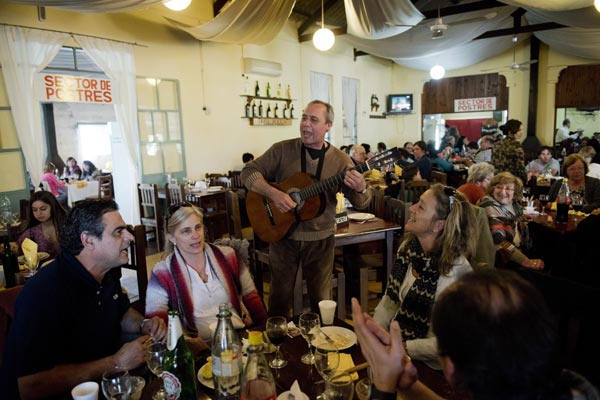Wine, olive oil and the good life
By Danielle Pergament ( Agencies ) Updated: 2015-02-28 09:19:31
 |
|
Bottles of tannat wine at El Legado. Matilde Campodonico / Agencies |
Marzuca pulled out the plug from the top of the barrel, inserted a long glass syringe, drew out some wine, nearly black, and dispensed it into a glass. The tannat grape, the pride of Uruguay, produces the "wine of the machos", so-called because it's quite strong. It was rich and lush and tasted faintly of berries.
"My father planted these vines," said Marzuca, pride swelling in his voice as we walked through his vineyard at dusk. "Tannat grapes grow better in sandy areas, and I think they have grown quite well here."
The sky had slipped from orange to red to black. It was time to head back to CampoTinto for the night. We piled into Vigano de Narvaez's 1951 lime green Studebaker-almost everyone here drives a 1940s-or '50s-era car (when not traveling by horseback or bicycle). "We like the old cars," Vigano de Narvaez said over the rumble of the engine. "In Carmelo, if something is not broken, we do not fix it."
The next day, we put our tannat expedition on hold and delved into another famous crop. In the shadow of wine countries all over the world, there is usually olive oil-and in southwestern Uruguay, the olive oil of reckoning comes from Familia Longo.
"This place was a real mess when I took it over," said Dolores Longo, the owner. The following day, we were strolling through her olive grove, the late afternoon sun giving way to a slow chill in the air. "I didn't know anything about how to make olive oil-I had to teach myself."
What she learned eventually led her to make three different types of olive oil: grassy manzanilla, fruity arequina and the pungent and peppery coratina arbequina. "If you don't process the olives within a few hours, the oil suffers," Longo said, as we ended our tour in her tasting room.
And yes, at this point, Uruguay was beginning to seem like a series of very cute, very charming tasting rooms. My palate, spoiled, indulged and exhausted, demanded a break.
"Punta Gorda," said my friend Matias, a Patagonian farmer of few words. "You must see it."
There are two things to know about Punta Gorda, a fleck of a town 20 minutes (by modern car) from Carmelo: It's considered kilometer zero for the Río de la Plata, and like so many points on the coastline of South America, it boasts a connection to Darwin (the Beagle stopped here on Darwin's famous voyage of the 1830s).
Standing on a hilltop, overlooking the muddy, roiling river, we could see Argentina in the distance. "It's close," said Astrid. But this quiet pocket of wine country, she added, "is a world away from the rest of the world, isn't it?"
|
|
|
|
|
|
|
|

























 Raymond Zhou:
Raymond Zhou: Pauline D Loh:
Pauline D Loh: Hot Pot
Hot Pot Eco China
Eco China China Dream
China Dream China Face
China Face






